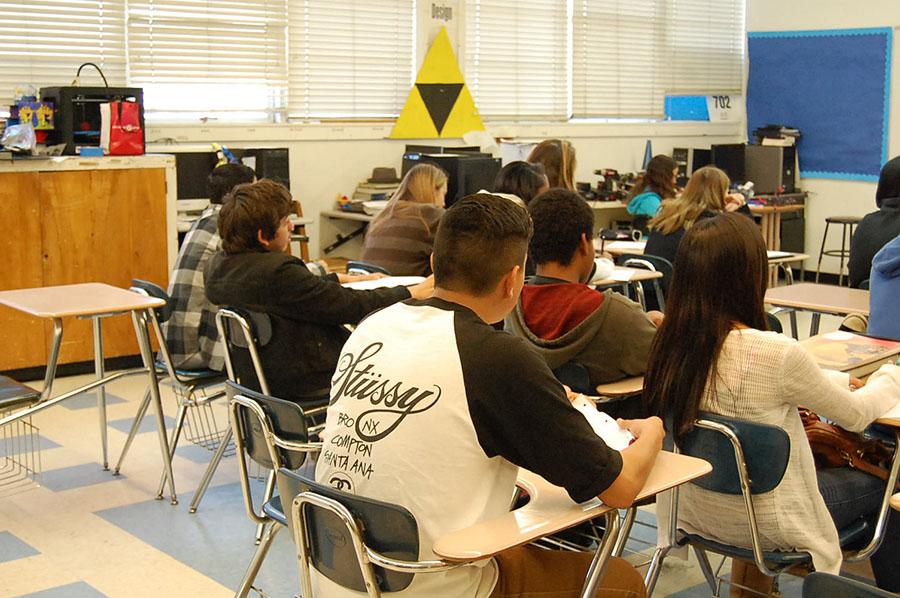New Math Methods: Help or Hindrance to Learning?
Students in their CCHS math class.
December 2, 2014
The new system in place in our math classes has generated a good deal of controversy since it was introduced at CCHS two years ago. Some students dislike the grading system or wish that the program was introduced only at lower grade levels, so that children will have more time to adjust to it.
Many students conflate the new protocols of their math classes- little or no homework, grades based exclusively on test scores, and active practice during most of the class period- with the Common Core standards that are being adopted throughout the country.
In fact, the Common Core standards offer little or no suggestions on teaching methods. They are merely lists of expectations regarding what students will have learned at the end of each grade level. The new structure of math classes at CCHS is a result of a partnership between CCHS and LMU called Math Leadership and Learning by Design (MLD). The program is meant to complement Common Core: “in response to the higher standard, Culver City is trying to provide more tools for better teaching,” said one math teacher.
No one can object to the ideas behind MLD; of course we want students to grasp the bigger concepts and achieve a deeper understanding of the material that goes beyond rote memorization. The question is whether the new system is really effective at achieving those goals.
The MLD uses a five step teaching process which students have probably experienced in their math classes. First comes a “hook,” a visual or prompt often taken from popular culture that is supposed to engage students’ attention and relate to the topic. Next comes an IBE (Investigation Before Explanation) problem, which students are supposed to analyze but not solve. Then, in the third step, the teacher supplies students with notes and explains how to do the problems. Step four is “active practice,” in which students attempt to solve problems on their own and with assistance from the teacher and their peers. The last step is for students to create an “action plan,” which they will use to evaluate their strengths and weaknesses and “further their learning.”
There is little or no homework- students are supposed to practice problems they have difficulty with in their free time, but the homework is never graded or checked. The majority of class time is spent in active practice, which essentially replaces homework.
The problem with this system, as I see it, is that it requires a much higher level of student commitment and participation to be successful than a traditional teaching format does. In a traditional math class, almost all students will be forced (through nightly graded homework and frequent tests that count toward the final semester grade) to achieve at least some limited understanding of the material. They may not have a perfect understanding of the underlying concepts, but through enforced practice, most have developed the ability to solve the problems and have a relatively serviceable command of the subject. This system, clearly, has its flaws, but at least all students are pushed or cajoled into some understanding of the material.
In contrast, in a MLD classroom, students experience no such enforced learning. They are given some notes and then turned loose for the rest of the class period for active practice. While the goal is for students to spend this time practicing and developing a deeper understanding of the material, many students will spend much of the class period talking rather than working. They may complete a few problems, see that their answers match the answer key, and conclude that they are done for the day. When testing time rolls around, these students either realize that they do not, in fact, recall the material, or do well and answer the problems correctly but without gaining a deep understanding of the concept. Not all students will be like this, of course. Some will truly spend class time studying and will come to have a much deeper grasp of the material than they would have achieved in a traditional math class. But I think it is safe to say that this group of students is in the minority.
Overall, I’m not sure that students’ understanding of the material is any deeper under the new system than it was under the old. Without enforced homework, students practice just enough to do well on tests, but not enough to really retain the material. So I think that in some ways, the MLD program compounds the problem it attempts to solve- the problem of students learning just enough to ace the test and not enough to actually retain the information.
I don’t mean to suggest that the students at our school are slackers or care only about their grades, and not their learning. But I think that we have been raised in an environment that promotes a grade-based sense of achievement. We’re used to having our work checked and graded, and because of that many of us will take advantage of a system that does not penalize failure to practice.
I also don’t mean to suggest that we need to return to having twenty to forty math practice problems every night. I do think, however, that students should be assigned a set number of problems to complete every day, and that if these are not completed during class time, they should be finished as homework.











































































